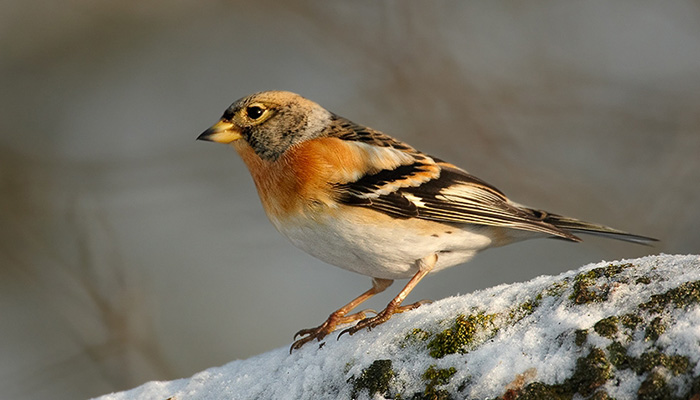
English: Brambling
Russian: Юрок, Вьюрок
Mongolian: Алаг бужирга, Алаг хуухуур бялзуухай
German: Bergfink
French: Pinson du nord
Japanese: アトリ (Atori)
Body
length:14½
- 16 cm.
Common breeder in upland birch forest of Fenno-Scandia; absent from
dense, tall forest, prefers more open coniferous with some deciduous growth.
Summer visitor to breeding sites (mostly mid Apr-Oct), winters in C and S
Europe, but in mild winters many remain in S Scandinavia. Rather shy. Food
mainly seeds, in summer also insects and in winter often beech nuts. In some
winters when beech mast plentiful, enormous flocks gather around beech trees.
Builds nest tree fork, generally in birch, also in spruce.
Identification:
Same size and shape as Chaffinch, but in all plumages recognized by white rump
(tinged yellow on juvenile) and little or no white rump (tinged yellow on
juvenile) and little or no white on sides of tail. Like Chaffinch, has pale
wing markings, but these are partially rusty-yellow as well as narrower and
less conspicuous. Flight as Chaffinch’s, but single-species passage flocks are
often somewhat more compact.
- ♂ summer: Head, nape, shoulders and mantle glossy
blue-black. Throat, breast and lesser wing-coverts unspotted rusty-yellow. Some
dark spots on lower flanks. Bill black.
- ♀: Crown, mantle /back and nape-sides
rather dark grey-brown, head-sides and central nape paler buffy grey-white,
breast buffish.
- ♂ winter: Black areas of summer plumage partly concealed by
fairly broad rusty-buff fringes, giving somewhat piebald appearance. Bill
straw-yellow with dark tip. Most reliably told from ♀ by black showing through
on entire head-side. Younger ♂♂ have black-spotted lesser coverts and broader
pale fringes to upperparts.